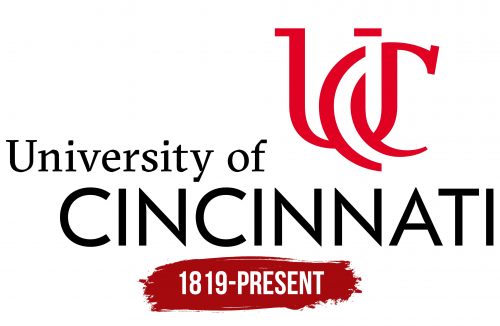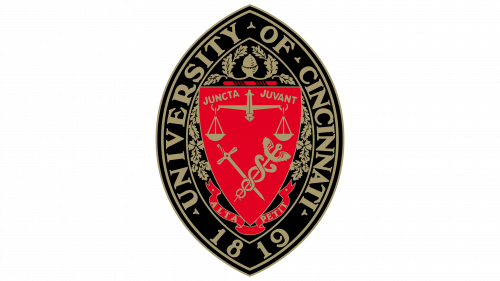 University of Cincinnati Logo PNG
University of Cincinnati Logo PNG
The University of Cincinnati logo elegantly presents the academic organization through letters and symbols. Its conciseness and minimalism captivate attention. The goal of the identity is not to attract attention but to identify the organization. The logo remains unchanged, containing the institution’s name and a monogram.
The color scheme appears simple, but it is quite distinctive. Classic colors were chosen, harmonizing well with each other. An unconventional choice was using multiple fonts within the same logo, which had a positive effect. The black letters and the bright red monogram in the upper right corner stand out on a white background.
Reliability and authority are highlighted very distinctly. The logo conveys these qualities of the educational institution through its lettering, emphasizing the high status of the academic center in Ohio.
University of Cincinnati: Brand overview
Among American universities, the University of Cincinnati has one of the richest histories, dating back to the middle of the 19th century.
The Medical College of Ohio was founded in 1819, marking the beginning of the university. This institution established the first medical college west of the Allegheny Mountains. At the time, Cincinnati was still a frontier community, and establishing a medical school marked a turning point in the area’s growth.
The Medical College of Ohio was one of the many colleges that the city of Cincinnati combined to form the University of Cincinnati in 1870. As a result, this institution is now the country’s second-oldest municipal university. William Howard Taft, the 27th President of the United States, served as the university’s first president.
The university expanded and changed over the late 19th and early 20th centuries. The College of Education was formed in 1906, while the College of Business was founded in 1912. These additions greatly increased the educational options offered by the institution.
The establishment of cooperative education marked a turning point in the university’s history. Herman Schneider, the dean of the College of Engineering, instituted a curriculum in 1906 that mixed theoretical instruction with hands-on experience in the industry. Numerous other universities across the globe soon imitated this ground-breaking educational approach and swiftly established itself as a trademark of the institution.
The university started aggressively growing its campus in the 1920s. Creating a master development plan included plans for a new campus designed in the Neo-Gothic style. Many buildings built during this time are still important architectural symbols for the university.
The institution experienced financial challenges during the Great Depression of the 1930s but persevered because of the community’s support and efficient management. During this time, the university kept expanding its academic offerings, most notably by establishing the College of Applied Arts.
Like many other American universities, the institution saw tremendous development following World War II. The GI Bill-eligible veterans among the growing student body encouraged campus growth and the development of new academic offerings.
The university kept growing during the 1960s. The student union, library, and medical facility all received new structures. Two new institutions were founded then: the College of Community Services and the College of Design, Architecture, Art, and Planning.
The institution’s status underwent a shift in the 1970s. 1977, it became a state school and part of the Ohio state higher education system. This modification created additional funding and development opportunities.
In the 1980s and 1990s, the university continued to bolster its research capacities. The Institute for Space Research and the Center for Genomic Research are two examples of new research centers and institutions that were established.
The institution started a massive campus revitalization initiative at the start of the new century. This project, which started in 1989, greatly enhanced the university’s infrastructure by constructing new buildings and renovating old ones.
The university continued to strengthen its areas of strength in the early twenty-first century. Innovations in education and multidisciplinary research received particular emphasis. Additionally, the institution widened its global network by forming alliances with other academic institutions worldwide.
The university commemorated its 190th anniversary in 2009, solidifying its place among the nation’s most illustrious and established academic establishments. The university has a long history of producing notable alumni, including politicians, corporate executives, artists, and Nobel laureates.
The institution unveiled “UC2019,” a comprehensive development plan, in 2010. The plan’s objectives were to improve the student experience, increase research activities, and fortify academic programs.
A brand-new medical campus with cutting-edge research labs and classrooms opened its doors in 2011, greatly enhancing the university’s standing in medical teaching and research.
The “Room for Innovation” program was introduced in 2012 to establish more technologically advanced and engaging learning environments.
Being one of the oldest medical schools in the country, the university commemorated the 200th anniversary of the Medical College in 2014.
The Bearcats football team won the American Athletic Conference championship in 2015, marking a milestone for the institution’s athletic programs.
2016, the Lindner College of Business opened as a new student center. It accommodated cutting-edge teaching techniques and was furnished with contemporary technology.
The amount of research conducted in 2017 saw a notable increase. At $417 million, sponsored research volume hit a record high.
The institution’s introduction of a new online learning platform in 2018 increased student access to education globally.
A $1 billion campus makeover project that included the construction of new academic buildings, residence halls, and sports facilities was completed in 2019.
Notwithstanding the world’s difficulties in 2020, the institution kept expanding its research initiatives, especially in technology and medicine.
The University of Cincinnati is represented by the Cincinnati Bearcats, a team that competes at the NCAA Division I level. The team actively participates in various sports, including football, basketball, and baseball. The Bearcats are known for their successful performances in the Big 12 Conference and have a long history of athletic achievements. The university supports sports programs that promote student-athlete development and strengthen student team spirit.
The university’s sports programs had a major boost in 2021 when it was revealed that it would join the elite Big 12 Conference, which increased its prominence in intercollegiate athletics.
In 2022, the institution introduced “Next Lives Here,” a new program designed to expand innovations in research and education even further.
During this time, the university maintained its strong standing in national and worldwide rankings, especially in research, engineering, and medicine. As part of its global outreach, the institution increased staff and student exchange programs and forged alliances with other academic institutions worldwide.
Notably, the university kept refining its distinctive cooperative education program, which is still among the best in the world and draws students from all around the nation.
Meaning and History
What is University of Cincinnati?
It is a university renowned for its wide range of academic offerings. It offers many undergraduate and graduate programs in various fields such as business, engineering, health sciences, arts, and sciences. The university’s cooperative education program is known for combining classroom learning with hands-on work experience. The university’s urban campus combines modern and historic buildings, reflecting its modern focus and historical heritage. The university is known for its active research programs and ties to regional businesses. The university’s athletic teams, the Bearcats, are known in college athletics and compete in the American Athletic Conference.
1819 – today
The University of Cincinnati logo embodies a blend of dynamism, simplicity, and vibrancy, highlighting the institution’s modern approach to education and innovation. It was developed well after the university’s founding in 1819, when it had already established itself as an influential educational institution.
The logo’s central element is a stylized depiction of the interlocking letters “UC,” rendered in bright red. This color symbolizes energy, passion, and a drive for growth—qualities inherent in the university’s students and faculty. The lines forming the “UC” are smooth and curved, adding a sense of dynamism and movement to the emblem.
The university’s name is divided into “University of” and “Cincinnati.” The first part is written in small font and aligned to the left, creating a sense of lightness and subtlety. The second part, “Cincinnati,” is written in large capital letters and is prominent beneath the “UC” abbreviation. This design emphasizes the importance of the city of Cincinnati in the university’s life and history.
The font used in the emblem combines both classic and modern elements. It appears formal yet contemporary, making the university’s visual mark recognizable and appealing.
The Seal
Along with the logo, a seal symbolizes the university’s value and carries deep meaning. Some argue that the seal is the most important element of any educational organization. The University of Cincinnati uses its seal to the fullest extent, reflecting significant informational blocks.
The university seal vividly and visually conveys the goals and objectives of its educational programs. Letters and a few words indicate the university’s main areas of activity and aspirations. Color plays an important role, highlighting the contrast between the dark background and bright details. The focus is on the main elements, of which there are more than ten on the seal.
The angular frame shield creates a unified perception of the seal. Several outlines give it scale. At the bottom of the shield, the university’s founding date is highlighted in gold. Letters accompany the numbers, forming a textual outline.
The central part of the seal is bright red, attracting attention. The emphasis is on the images inside the shield. Law and science are the main areas of the university’s educational programs, symbolized by the shield and scales of justice. The sword is a significant element in shaping the understanding of educational goals.
Like many universities, the University of Cincinnati uses Latin words on its seal. In an elegantly crafted font, two words can be read: “Juncta” and “Juvant.” The first means “strength,” and the second—”unity.” The phrase “Alta Petit” instructs students to aim for goals, not fear obstacles, and seek paths to personal and collective victories.





